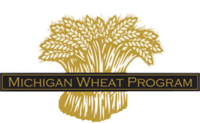Lansing, Mich. (July 22, 2020) – As the state’s golden wheat crop is harvested, the Michigan Wheat Program announced that Governor Gretchen Whitmer has proclaimed July 2020 as Wheat Month in Michigan. The official proclamation from the Governor notes that wheat is grown on nearly 5,000 Michigan farms, producing approximately 36 million bushels of wheat on a half-million acres.
The annual farm-gate value of Michigan wheat is $249 million. Value is added to the crop by the state’s six mills and processors, which produce breakfast cereals, soups and wheat flour used to make pastries, cakes, baking mixes, cookies, pretzels, pies and crackers, among other products.
In making the proclamation, Gov. Whitmer “joined with the Michigan Wheat Program in celebrating the importance of Michigan’s wheat farmers and all of the millers, food companies and businesses that utilize the bountiful wheat crop.”
This tribute to Michigan wheat farmers as they bring in the crop is fitting, said Dave Milligan, outgoing 9-year chairman of the Michigan Wheat Program, who is also the 2020-2021 president of the National Association of Wheat Growers.
“Michigan wheat farmers perform exceptionally well, producing on average 80 bushels per acre vs. the US average of 52 bushels per acre,” Milligan said. “As the board of the Michigan wheat program, we work toward investing in research with the dual goals of even stronger yields and higher quality.”
Quick facts about Michigan wheat:
- About 5,000 Michigan farmers planted 520,000 acres of wheat last fall, of which 460,000 acres will be harvested. Some acres are not harvested due to maturity issues, winter or water damage.
- Wheat is grown on 5,000 farms in the Upper and Lower Peninsulas, in at least 78 counties.
- Michigan farmers will harvest about 37.2 million bushels of wheat by the end of harvest, according to the US Department of Agriculture.
- The average Michigan wheat farm will harvest 81 bushels to the acre this year, compared with the national average of 52 bushels per acre.
- 2016 was Michigan’s highest-recorded harvest, yielding 89 bushels per acre. This year won’t hit that record, but is 55% above the national average.
- Once harvested, wheat travels either to a local elevator or mill or is stored on-farm. It is purchased during the rest of the year by elevators, processors, millers, distillers and brewers.
- Almost all Michigan wheat is processed into food products within the great lakes region – keeping value-added food production in Michigan and enhancing profitability for the farmer.
- Michigan produces winter wheat, which is planted in the fall and harvested the next summer. Wheat helps reduce erosion because it provides ground cover during the high-rain periods in fall and early spring. Wheat also enriches soil by capturing nitrogen and adding organic matter.
- Michigan’s top-five wheat producing counties are Huron, Sanilac, Lenawee, Tuscola and Saginaw.
The MWP is a check-off organization funded by the state’s wheat farmers who grow wheat in at least 78 of Michigan’s 83 counties. The Michigan Wheat Program promotes the state’s wheat industry by funding and supporting the strategic priorities of wheat farmers by working with input suppliers, seed producers, millers, end users and consumers. Research and grower education are top priorities for the organization. For more information visit miwheat.org.
